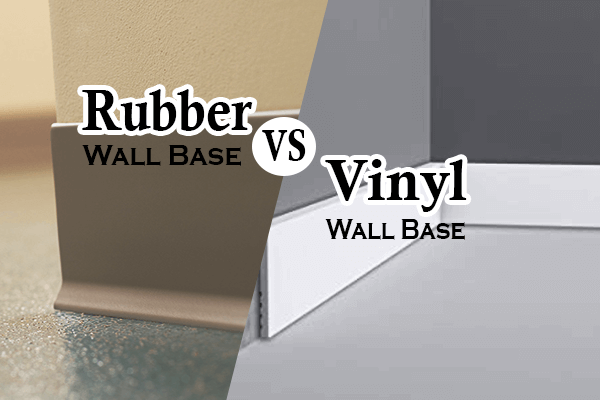Whether you are a new or old homeowner, there are certain necessities you must consider when building or renovating your home. A great example is the type of wall base used. Wall bases do not serve only aesthetic purposes; they also serve as a cover for floor finishes and sound-proof systems.
Wall bases come in various types based on materials, with the two most popular being rubber and vinyl wall bases. If you are reading this, it’s probably because you are stuck between choosing which of these wall bases is more suitable for you. Fortunately, this article examines the definition of wall bases, the differences and similarities between rubber and vinyl wall bases, and how to choose one for your home project.

Contents
What Are Wall Bases And What Are the Types?
A wall base is a type of molding or trim that covers the gap between the lower portion of an interior wall and the floor. It is typically installed between the base of the wall and the floor, where the floor and the wall meet, to cover the uneven joints and finishes.
Wall bases come in different types and they include:
- Rubber wall bases
- Vinyl wall bases
- Mixed (Rubber and Vinyl Blend) wall bases
- Wood wall bases
- Steel wall bases
- Carpet wall bases
While wall bases are made of different materials, they also come in various styles. The style used per project depends on the type of flooring, project design, type of wall, and ultimately, the owner’s preference. Some popular wall base styles include straight, butt-to-wall, and cove wall bases.
Are Rubber and Vinyl Wall Bases Similar?
Nowadays, Rubber and Vinyl wall bases are preferred over conventional wall bases like wood and steel. Although they are made of different materials and vary in certain characteristics, they share some common features that make them better options for most building projects. A few of these characteristics include;
Cost
Each wall base varies in cost based on the material and manufacturer. However, rubber and vinyl wall bases are less expensive than other traditional ones. Vinyl and rubber base floorings are also durable and, as such, need little to no maintenance. This implies a reduced overall cost of purchase and maintenance.
Performance
Thermoset and thermoplastic rubber base wall and thermoplastic vinyl base wall meet the ASTM – F1861 performance requirements.
Durability and Aesthetics
Rubber and Vinyl wall bases are highly durable – they can withstand heavy traffic and last long with good maintenance. Also, both have outstanding aesthetic value: they usually come in various colors and designs. This gives you an endless choice to choose from for your project.
Installation
Both types of wall flooring are easy to install and sometimes even require little expertise.
Rubber Vs. Vinyl Wall Base: Which is Best?
Rubber and Vinyl wall bases differ in many ways, and these differences go beyond the type of material. Most specifiers refer to rubber wall bases as the first option and vinyl wall bases as the second. To help you understand which is best for you, here are some factors to consider when choosing;
Cost
While rubber and vinyl wall bases cost less than the traditional types, they differ in price. Rubber wall bases usually cost more per square foot than vinyl wall bases. However, the higher price is worth it because it requires less maintenance and can last a lifetime.
Water resistance
On the other hand, vinyl flooring bases have limited application because of the tendency to develop molds after long-term exposure to water or moisture.
Installation method
Although rubber and vinyl wall bases are easy to install, they require different installation processes. For instance, rubber requires no adhesive and can be installed by laying them in place – on an even, smooth surface. Conversely, vinyl wall flooring requires click-and-lock or glue-down products to stick and remain in place.
Durability and resilience
On the other hand, rubber wall bases have a longer lifespan. Good quality rubber wall bases can last up to 30 years, with good maintenance. They rarely crack or get any creases even after prolonged use.
Odor and air quality
The type of wall bases you install in your home can have an impact on your home’s air quality. But, the impact made varies based on the type of flooring or wall bases used.
One of the major factors that influence the impact each wall base has is the materials from which it is made. For example, vinyl wall bases are made from petroleum and produce a rubbery smell on installation. They also produce certain harmful chemicals – VOCs (Volatile organic compounds), that are unsafe for your health and the environment.
Meanwhile, rubber produces no smell or harmful chemicals. But, some recycled rubber may give off certain gases that may be harmful.
When purchasing a wall base, ensure that you confirm that the base produces low levels of VOCs or harmful gases.
How To Choose the Right Wall Base
When designing or renovating a home, it is paramount that you give due attention to the type of wall base used. The type of wall base used influences the project’s overall appearance, cost, and lifespan. Here’s a guide on how you can choose a worthwhile wall base.
Determine the thickness needed
Wall bases usually come in two standard thicknesses – ⅛ inch (3.2mm) and 0.080 inches (2mm). Wall bases that are ⅛ or .125 inches thick are usually preferable because they cover building inconsistencies better and give greater protection from traffic abuse.
Determine the right wall base height
Wall base height differs based on the size and shape of the room, and it usually measures between 2.5 to 6 inches. They come in three standard heights of 2.5 inches (6.4cm), 4.0 inches (10.2cm), and 6 inches (15.3cm).
Shorter wall bases are the recommended option for homes, while taller ones are best suitable for places with very high traffic, such as hospitals.
Select the right wall base color
The wall base color is as important as the color of the continuing wall and floor.
Choose your preferred wall base style and design
There are different styles and designs when it comes to wall base designs, including flat, cove, and butt-to-wall styles.
Your choice of style and designs ultimately depends on the complexity of the wall, type of flooring, type of room, and your preference. For instance, flat, toeless, or straight wall bases which run from the top (wall base) to bottom (floor) without any indentation detail are suitable for hallways and staircases.
Other essential factors to consider when choosing the most suitable wall Barlow for your home includes the type of material, cost of wall base, and the installation method used.
Conclusion
Although rubber and vinyl wall bases differ in material and source, they share some striking similarities. They are cost-effective, easy to maintain, and durable.
Nevertheless, these similarities are nothing compared to the multiple differences between them. This piece has extensively discussed the differences and peculiarities of both types. And, using the information provided, you can decide which is best and select the most suitable option for your home.
